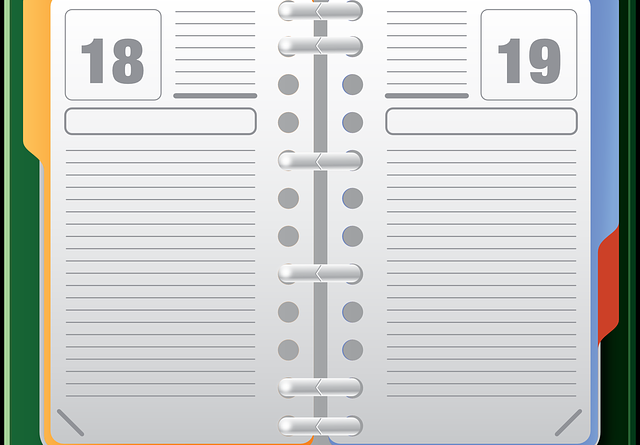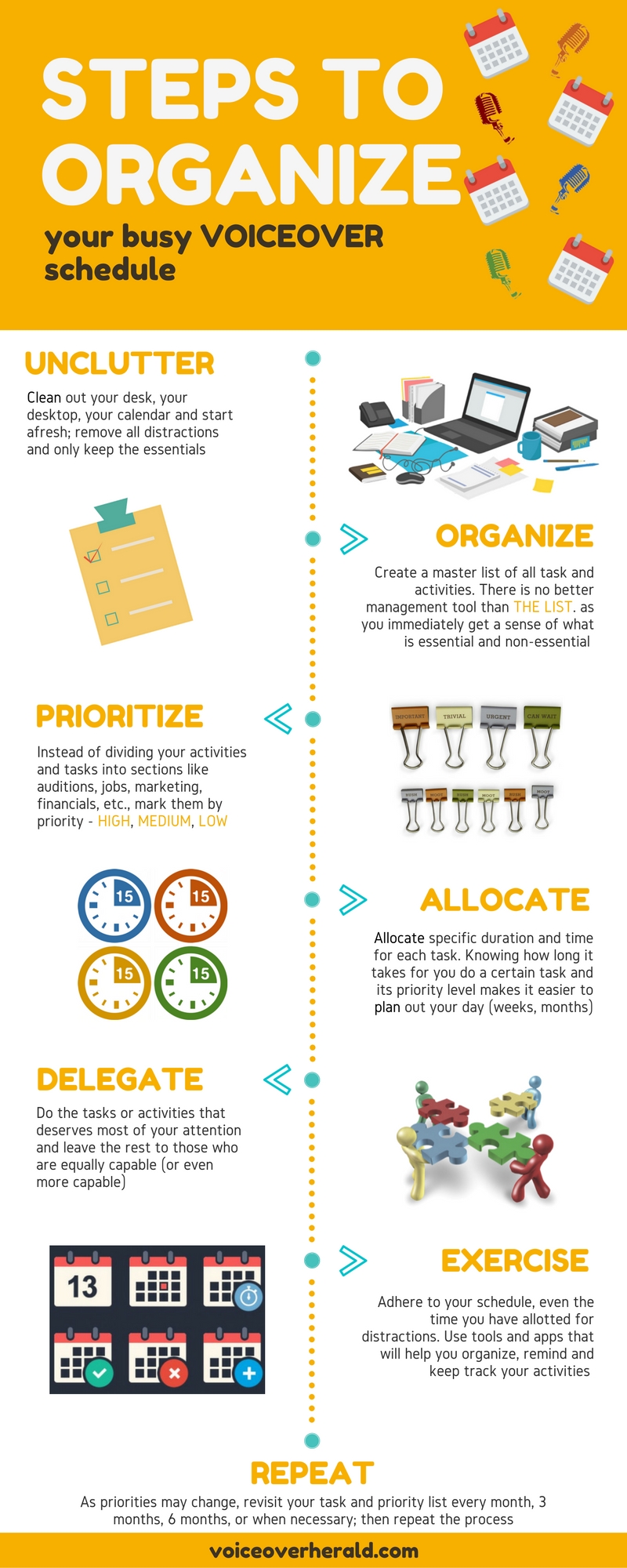Steps to Organizing Your Busy Voiceover Schedule
As someone who works in the arts, voice over artists are naturally inclined to focus on the tasks that involve their talent. However, the more time you spend with inside your recording booth, the less time is spent in managing the rest of your business. This means you are losing time to connect with current and future clients, and create activities that leverage your voice over career to be on top of the industry.
Here are steps to help you maximize your productivity in all aspects of your voice over business, and help you get some time back to pursue other things that you enjoy in life.
Unclutter
Start off with a clean desk. Nothing helps better than an uncluttered desk to unclutter a busy schedule. All the papers, folders, boxes, scripts notes, etc. scattered all over your desk and office are distractions. Unclutter our computer desktop too. All the files and programs pinned to your desktop and taskbar are again distractions. Keep only the most essential tools your need, and then all the rest should be organised and classified in your My Documents folder, or better yet on the Cloud.
Organize
The best and most effective management tool you can use is THE LIST.
Create a master list of all task and activities that you are currently doing, and what needs to be done – both in your voice over business and personal life. Sitting down and writing a list gives you clarity and puts order to your chaos much faster that any management tool. And as you list down everything, you will immediately get a sense of what are the essentials and non-essential activities; what you need to stop doing and what you need to start immediately.
Adding your personal do’s and must haves, gives you a broader perspective and realigns your mindset – that the most important part of having a well-organized schedule is allowing you to have a work-life balance.
Prioritize
A common mistake in organsing tasks is dividing it in sections – like Voice Over Projects, Auditions, Marketing, Financials, Administration, etc. The problem with organizing your activities this way is that it makes you gravitate to the tasks you are most comfortable doing, like being in your studio, and then missing out on the other tasks no matter how important they are. Instead, segregate your activities in terms of priority.
Break down your “essentials” even further by marking them off as HIGH, MEDIUM AND LOW. Putting on top of the list your high pay-off activities – whether it be in terms of business improvement, financial gain, fostering business relationships, and personal fulfillment.
To help set the priority level of a task, ask yourself: What value or opportunity would I gain if I spend more time with this task?
Remember that the 80:20 rule also applies to your workload. 80% of your activities contributes to less than 20% of its value. Put high priority then to the crucial 20% of your workload as it will yield a stronger gain.
Allocate
Time management is actually a misnomer. Time can’t be managed as it runs out whether you like it or not. However, what you can manage is your tasks – the number of task that you do, the amount of time you spend on it. So instead of worrying about how many hours there is in a day, worry about the activities that you can squeeze in in the amount of time you have.
In your list, allocate specific duration that you will need to spend for each task. Knowing how long it takes for you do a certain task and also its priority level makes it easier to designate a day when you need it done, and when in that day it should be done. The beauty of knowing the priority level of an activity is that you can schedule it on a daily, weekly, monthly and even quarterly, depending on its level, instead of trying to cram everything in a month, or worst in a week.
When allocating time, also be realistic by allowing some time for distractions or interruptions. This is the time for you to do ad hoc tasks or urgent queries. Even if you need to do certain tasks within certain times, having this allowance helps you get back on track even with a bit of interruption.
Delegate
Why spend 40 rushed hours doing 30 various activities, when you can spend 40 quality hours doing 15 high pay-off tasks?
Having your priority list helps you decide which activities deserves most of your attention. You can now focus on the work that you will stand to gain the most, while leaving the medium or low priorities for others to do – whether it be a family member who is willing to help out, a personal or virtual assistant, or even a hired expert to do you administrative, marketing and finances.
Exercise
Once you have laid out everything, you have to be religious in adhering to your schedule otherwise it will be difficult for you to pick things up again where you left off.
There are time management systems and apps available that can aid in you in organizing, reminding, accomplishing and keeping track of your activities. Here are some:
Evernote a free productivity tool that lets you capture your ideas, images, notes and voice. You can record meetings and interviews, create lists, and share files. It has grown to be a full-pledged business tools with collaborative features.
This is an alternative to your timesheet that lets you track how much time you spend on a project or task.
This task management system helps you focus on your tasks and reach your objectives. It generates a to-do list and priority actions.
Any.do is a reminder app that shows everything you need to do for the day. It tries to keep your to-do-list from getting overwhelming.
Google Drive is a great productivity app that lets you collaborate and work offline. It offers Google Docs, Sheets, Slides and Forms that you can easily share with the rest of your team.
Repeat
As priorities may change, revisit your task list every month, three months, 6 months or when necessary.
By re-aligning yourself again with your priorities, it allows you to improve or update the processes, structures you have in place. Also lets you re-evaluate your skill and decide if you can continue doing certain tasks, or if you need to hire someone to do it for you.
Repeating this process helps you rid of activities that has become a non-essential and assess what activities hold more value. So repeat…
When you have these structures in place, day to day work can be undertaken more efficiently and effectively, leaving you more time to spend with yourself, your family and friends.


